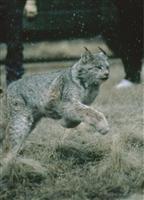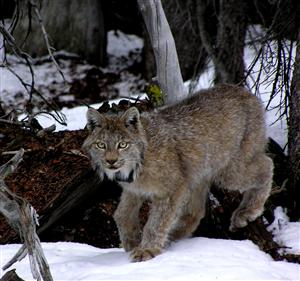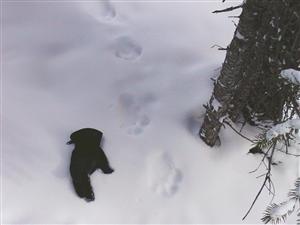 If you have seen lynx in Colorado, we would like to hear about it! Please fill out our Lynx Sightings Form so that we can keep better track of our precious lynx population.
If you have seen lynx in Colorado, we would like to hear about it! Please fill out our Lynx Sightings Form so that we can keep better track of our precious lynx population.
Thanks again to all who have called in sightings - these really help us when we fly for lynx. Please know that we follow up on all sightings (usually with flights in the area of the sighting) as soon as possible.
Identifying a Lynx or Lynx Tracks
A lynx is very similar to a bobcat. They are both about the same size and have ear tufts, facial ruffs and a short tail. Still, there are several distinguishing characteristics to look for.
| Bobcat | Lynx |

|  |
Distinguishing Characteristics
Foot size: The size of the feet of a lynx are very large compared to that of a bobcat. The feet of a lynx will look out of proportion to the rest of  their body. A bobcat has much smaller feet, which appear proportional to the rest of their body, as if it were a very large house cat.
their body. A bobcat has much smaller feet, which appear proportional to the rest of their body, as if it were a very large house cat.
Tail: The tip of the tail on a lynx is completely black, as if the tail had been dipped in ink. The tip of the tail of a bobcat has a black spot on the top and is white underneath, the tail will often have several black stripes. The tail of a bobcat is also usually longer than a lynx, although they both have the short tail, which easily makes them distinguishable from any other wild cat.
Collars: Lynx in Colorado are released with radio collars. Try to look for either the collar itself or for the 12 inch antenna that will lay across their back.
Coat and Coloring: The pelage of a lynx is typically long-haired and of a uniform coloring of grayish-brown in winter, with shorter hair that is more reddish in color in the summer. They lack distinct spots and striping. A bobcat will typically have distinct spotting on their coats. The front legs of a bobcat will often have distinct striping, as well as their faces.
Tracks: Because of the large feet on a lynx, their tracks are much larger than that of a bobcat. The lynx track will be about 5 inches across, the size of a female mountain lion. The bobcat track will be approximately 2.5 - 3 inches across. The stride on a lynx track (distance from one print to the next) is about 13". This shorter stride sets the lynx tracks apart from mountain lion tracks, whose stride is about 20". Mountain lion tracks often have the pad imprints visible. The individual toe pads and foot pad on a lynx is rarely visible because of the large amount of fur they have on their feet.
 To see more photos of the 5 distinguishing characteristics that distinguish lynx from bobcat, please see our Avoiding Incidental Lynx Take While Trapping and Hunting brochure.
To see more photos of the 5 distinguishing characteristics that distinguish lynx from bobcat, please see our Avoiding Incidental Lynx Take While Trapping and Hunting brochure.
There are also numerous excellent websites that show additional pictures of both species. A search for either species should lead you to plenty of useful sites to help you determine if you saw a bobcat or a lynx. A person typically only gets a very brief glimpse of a wild cat. Thus, you may never be able to know for certain what you saw. However, if you are aware of the distinguishing characteristics listed above, you can try to look specifically for those features when you get the opportunity.

